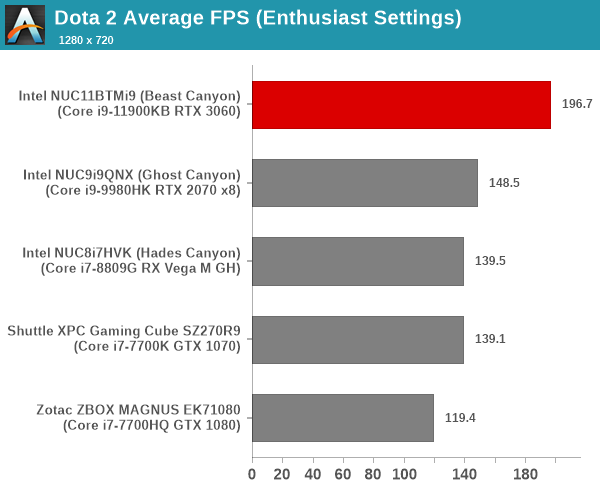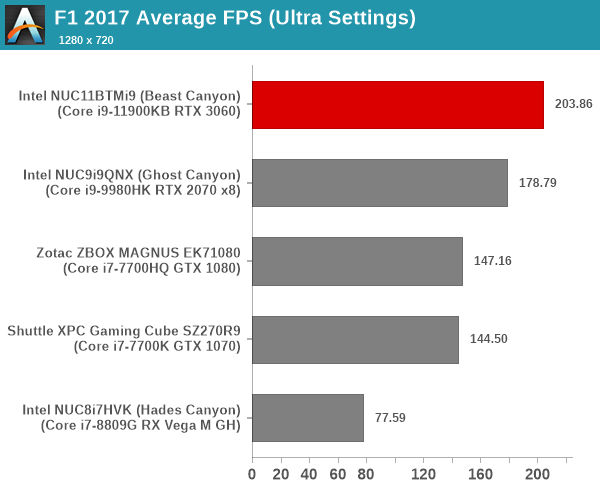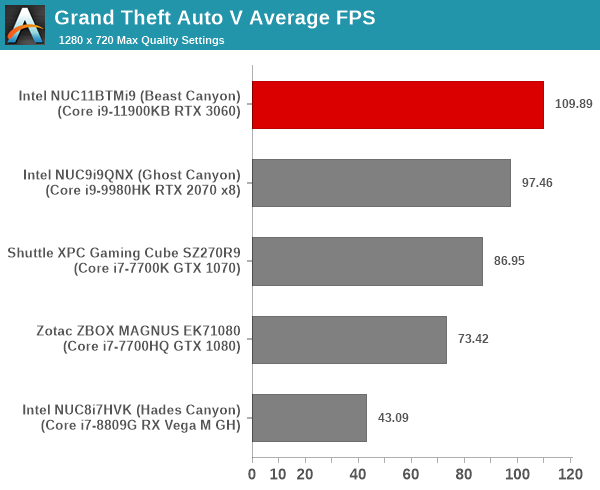Intel Beast Canyon NUC Review: Desktop Tiger Lake Debuts in SFF Gaming Powerhouse
by Ganesh T S on July 29, 2021 9:00 AM EST- Posted in
- Systems
- Intel
- NUC
- Tiger Lake
- NUC11
- Beast Canyon
GPU Performance - Gaming Workloads
The Beast Canyon NUC's gaming prowess was evaluated using our 2018 gaming test suite (to ensure we have a good set of comparison points from our previous reviews):
- Civlization VI (DX12)
- Dota 2
- F1 2017
- Grand Theft Auto V
- Middle Earth: Shadow of War
- Far Cry 5
Most system reviews take a handful of games and process them at one resolution / quality settings for comparison purposes. Recently, we have seen many pre-built systems coming out with varying gaming capabilities. Hence, it has become imperative to give consumers an idea of how a given system performs over a range of resolutions and quality settings for each game. With our latest suite, we are able to address this aspect.
Civilization VI (DX12)
The Civilization series of turn-based strategy games is very popular. For such games, the frame rate is not necessarily an important factor in the gaming experience. However, with Civilization VI, Firaxis has cranked up the visual fidelity to make the game more attractive. As a result, the game can be taxing on the GPU as well as the CPU, particularly in the DirectX 12 mode.
| Civilization VI (DirectX 12) Performance | |||

We processed the built-in benchmark at two different resolutions (1080p and 2160p), and with two different quality settings (medium and ultra, with the exact differences detailed here). All settings and resolutions point to the Beast Canyon being the runaway winner. It is the CPU capabilities that probably edge the scores here, given that the RTX 3060 and RTX 2070 perform quite similar to each other in most of the other workloads.
Dota 2
Dota 2 has been featuring in our mini-PC and notebook reviews for a few years now, but, it still continues to be a very relevant game. Our evaluation was limited to a custom replay file at 1080p resolution with enthusiast settings ('best-looking' preset). We have now revamped our testing to include multiple resolutions - This brings out the fact that the game is CPU-limited in many configurations.
Dota 2 allows for multiple renderers - we use the DirectX 11 mode. The rendering settings are set to 'enthusiast level' (best-looking, which has all options turned on, and at Ultra level, except for the Shadow Quality set to 'High'). We cycle through different resolutions after setting the monitor resolution to match the desired resolution. The core scripts and replay files are sourced from Jonathan Liebig's original Dota 2 benchmarking instructions which used a sequence of frames from Match 3061101068.
| Dota 2 - Enthusiast Quality Performance | |||

Dota 2 is not a taxing benchmark for these high-end systems, and the Beast Canyon is either comfortably on top, or within the margin of error when things are too close to call.
F1 2017
Our gaming system reviews have always had a representative racing game in it. While our previous benchmark suite for PCs featured Dirt 2, we have moved on to the more recent F1 2017 from Codemasters for our revamp.
| F1 2017 - Ultra Quality Performance | |||

The supplied example benchmark (with some minor tweaks) is processed at four different resolutions while maintaining the graphics settings at the built-in 'Ultra' level. The trend observed in previous games holds true here also, with the Beast Canyon emerging on top.
Grand Theft Auto V
GTA doesn’t provide graphical presets, but opens up the options to users and extends the boundaries by pushing even the hardest systems to the limit using Rockstar’s Advanced Game Engine under DirectX 11. Whether the user is flying high in the mountains with long draw distances or dealing with assorted trash in the city, when cranked up to maximum it creates stunning visuals but hard work for both the CPU and the GPU. For our test we have scripted a version of the in-game benchmark. The in-game benchmark consists of five scenarios: four short panning shots with varying lighting and weather effects, and a fifth action sequence that lasts around 90 seconds. We use only the final part of the benchmark, which combines a flight scene in a jet followed by an inner city drive-by through several intersections followed by ramming a tanker that explodes, causing other cars to explode as well. This is a mix of distance rendering followed by a detailed near-rendering action sequence.
| Grand Theft Auto V Performance | |||

We processed the benchmark across various resolutions and quality settings (detailed here). The results are presented above.Except for the 4KMax setting where the Ghost Canyon takes the lead, it is the Beast Canyon outperforming all other systems here.
Middle Earth: Shadow of War
Middle Earth: Shadow of War is an action RPG. In our previous gaming benchmarks suite, we used its prequel - Shadow of Mordor. Produced by Monolith and using the new LithTech Firebird engine and numerous detail add-ons, Shadow of War goes for detail and complexity. The graphics settings include standard options such as Graphical Quality, Lighting, Mesh, Motion Blur, Shadow Quality, Textures, Vegetation Range, Depth of Field, Transparency and Tessellation. There are standard presets as well. The game also includes a 'Dynamic Resolution' option that automatically alters graphics quality to hit a pre-set frame rate. We benchmarked the game at four different resolutions - 4K, 1440p, 1080p, and 720p. Two standard presets - Ultra and Medium - were used at each resolution after turning off the dynamic resolution option.
| Middle Earth: Shadow of War Performance | |||

The Ghost Canyon NUC and the Beast Canyon NUC perform very similarly at higher resolutions in this benchmark. Both outperform the other systems handily across the board, though.
Far Cry 5
Ubisoft's Far Cry 5 is an action-adventure first-person shooter game released in March 2018. The game comes with an in-built benchmark and has standard pre-sets for quality settings. We benchmarked the game at four different resolutions - 720p, 1080p, 1440p, and 2160p. Two preset quality settings were processed at each resolution - normal and ultra.
| Far Cry 5 Performance | |||

Similar to the other games, the RTX 3060 combined with the Tiger Lake-H CPU help the Beast Canyon come out on top across all resolutions and quality settings.
Overall, the Tiger Lake-H CPU's capabilities complement the prowess of the GeForce RTX 3060 nicely to provide a gameplay experience better than previous generation systems. As we shall see later on, this is at a lower price point while maintaining similar power consumption levels.










84 Comments
View All Comments
Spunjji - Friday, July 30, 2021 - link
"Can I buy the new compute element card and put it in a Ghost Canyon case?"I've been wondering that - I thought part of the point of the Element was to enable that sort of upgrade, but then I guess you'd lose the PCIe 4.0 compatibility
damianrobertjones - Friday, July 30, 2021 - link
Question: Can you purchase (I believe you can) JUST the element and place it into the previous model's chassis? That's what I was led to believe with this 'supposed' upgradability. If not, then possibly avoid this machine as there won't (probably) be an upgrade path. I did own the previous gen.Question 2: What the heck is going on with the smaller Nuc 11 units? I cannot seem to buy one ANYWHERE (u.k.).
mode_13h - Monday, August 2, 2021 - link
I think Tiger Lake is simply in high-demand. Intel likely prioritizes notebook OEMs above its own NUCs. Most NUC buyers probably don't know or care about the difference between 10th gen and 11th gen, so it's less bad to undersupply that market. Of course, this is all speculation.vol.2 - Tuesday, August 3, 2021 - link
I'm assuming they use the cheapest fans they can get away with. I'm sure the noise would improve dramatically if you replaced them with some better ones.Oxford Guy - Wednesday, August 11, 2021 - link
I’m sure the laws of physics are malleable.JoeDuarte - Tuesday, August 3, 2021 - link
1. It would help to benchmark them with more realistic specs, and consistent specs across the different SFF computers you included. 16 GB of RAM is too little for something this high-end, with an 8-core i9 Tiger Lake CPU, and a new-gen Nvidia 3060 GPU. (And you had 32 GB of in the Zotac...) 512 GB of SSD is too small for this kind of build, and there are big differences in SSD performance between 512 GB units and 1 TB+ sizes. (And you have different SSD models and sizes across the tested computers, ruining the validity of the results.)2. Intel's prices are still a bummer. I love the idea of a NUC, and of these X Canyon big-NUCs, but their prices and availability have always ruled them out. It's just worth it for what you get. We have to add several hundred dollars to that $1,350 price for this model. And hundreds more for a display, keyboard, and mouse. It's easily a $2,000 build, probably more like $2,300, all before taxes.
It makes more sense to go to PCPartPicker and build out a compact PC using one of those cuboid cases. They're a lot bigger than NUCs, but much smaller than mid-towers.
3. Intel really struggles with naming and model numbers. The NUCs are a messy jumble of letters and digits. And Intel commits the sin of having multiple names for the same thing, and you have to keep track of numerous confusing terms and their relation to each other. e.g.:
-- Goldmont vs. Apollo Lake, using Skylake arch, vs. Braxton vs. Willow Trail
-- Cherryview vs. Cherry Trail vs. Airmont
-- Beast Canyon vs. Bean Canyon vs. NUC vs. NUC11BTMi9
-- NUC11BTMi9 vs NUC11DBBi9, where the former is supposed to be a computer and the latter is a "Compute Element"
Nothing about the substring BTMi9 screams "computer", and nothing about the substring DBBi9 screams "Compute Element". It's all such a mess, and it makes it hard to shop for and buy Intel's products. If you don't already know the exact model number of what you want, there's no way to know from the model numbers that you encounter what you're getting or where it fits into the larger context of NUC models. These are things that any organization should be able to fix – clean, consistent naming, and clean, concise, and non-ugly model numbers.
mode_13h - Wednesday, August 4, 2021 - link
> It makes more sense to go to PCPartPicker and> build out a compact PC using one of those cuboid cases.
Except you cannot buy a Tiger Lake-H CPU. They're only sold in BGA and mostly found in laptops.
Unlike the Gemini/Jasper/Elkhart Lake CPUs (which are also BGA and often found in Chromebooks), you probably can't buy a mITX motherboard with them pre-installed, either.
JoeDuarte - Thursday, August 12, 2021 - link
I didn't think of that, though it wouldn't matter in my case. Whenever I build out a system at PCPartPicker I choose the Core i7-11700 or one of the Zen 3 chips – I think it's called a 5600 or 5800, but I forget. I don't think Tiger Lake-H would be an improvement from those, just maybe lower power.The GPUs are decent for integrated, and that has made me lean toward Intel because of the difficulty in finding current gen discrete GPUs like the 3060 Ti, but I haven't pulled the trigger yet. The Zen 3s don't have integrated GPUs, which would leave me without a GPU unless I settled for an obsolete 1650 or something. I'd rather live with the Intel 750 for a spell until the powerhouses are available at normal prices.
mode_13h - Friday, August 13, 2021 - link
> I choose the Core i7-11700 ... I don't think Tiger Lake-H would be an improvement> from those, just maybe lower power.
There are some notable differences. The desktop 11th gen CPUs are Rocket Lake, built on Intel's 14 nm++++ process, using Cypress Cove cores. Those cores are a 14 nm back-port of Ice Lake's (launched in 2019) Sunny Cove.
The Laptop & NUC 11th gen CPUs are Tiger Lake, which use Intel's 10 nm+++ node (also called 10 nm SF). They use Willow Cove cores, which are a generation newer than Ice Lake's (and therefore Rocket Lake's). However, the generational gains of the cores were modest, with the main difference being that Tiger Lake clocks higher.
Now, if you want to compare spec-for-spec, try this:
https://ark.intel.com/content/www/us/en/ark/compar...
The main thing that shows is that Tiger Lake-H has 50% more cache and the top-end model clocks lower. However, being a laptop chip, the top-end model also has a TDP of just 65 W. So, it's probably better to compare it with the fastest 65 W Rocket Lake:
https://ark.intel.com/content/www/us/en/ark/compar...
According to that, Tiger Lake-H is able to offer a much better Base clock, though its turbo is still lower. That's probably because its peak power is also lower, again being a laptop chip. Furthermore, clock speeds don't tell the whole story. In the end, specs are no match for actual benchmarks:
https://www.tomshardware.com/news/intels-enthusias...
These benchmarks show Rocket Lake pulling ahead in GPU tests, probably due to its faster turbo. However, when it comes to CPU-intensive tests, we see Tiger Lake hold its own.
Unfortunately, not many people seem to have run that exact comparison. Most are either comparing with the top Rocket Lake SKU or just other SFF PCs. If anyone else has benchmarks of the i9-11900KB vs. i9-11900, please share.
I guess the point is that if you care about power/noise/size, this NUC Extreme seems pretty compelling. If you're willing to spend a bit more and go for a top-of-the-line desktop, then you should probably fare better with Rocket Lake.
I wish Tiger Lake-H came in a LGA-1200 socketed version, so we could really see it stretch its legs. I'll bet it would beat even i9-11900KF by a noticeable amount.
> The Zen 3s don't have integrated GPUs
They do now! Check out the new Ryzen 5000G models!
https://www.anandtech.com/show/16824/amd-ryzen-7-5...
They're decent, for an integrated GPU, but not on par with the RTX 3060 in this NUC Extreme.
mode_13h - Wednesday, August 4, 2021 - link
> And Intel commits the sin of having multiple names for the same thing,> and you have to keep track of numerous confusing terms and their
> relation to each other. e.g.:
>
> -- Goldmont vs. Apollo Lake, using Skylake arch, vs. Braxton vs. Willow Trail
> -- Cherryview vs. Cherry Trail vs. Airmont
Goldmont is the core. Apollo Lake is the SoC. The "Mont" cores are the low-power ones. They've been very consistent about that: Silvermont, Airmont, Goldmont, Goldmont+, Tremont, and soon Gracemont.
Starting with Ice Lake, the big cores are named after coves, so far.
And the "Trail" names seem to be system designs, or something?
The one naming convention that really got out of control is the "lakes". Those seem to have very little consistent meaning. I think they have a few Lakes that aren't even CPUs/SoCs.
> Nothing about the substring BTMi9 screams "computer"
It's just a model number, dude. Just type it into a search engine and look it up. And some places I've seen will at least say it's a NUC compute element, although that requires you to know how one differs from a regular NUC.
> It's all such a mess
I will agree that Intel's product line is full of subtle variations, like NUCs with one vs. two Ethernet ports. I was staring at two Tiger Lake NUC listings, trying to figure out the difference, until I noticed that.